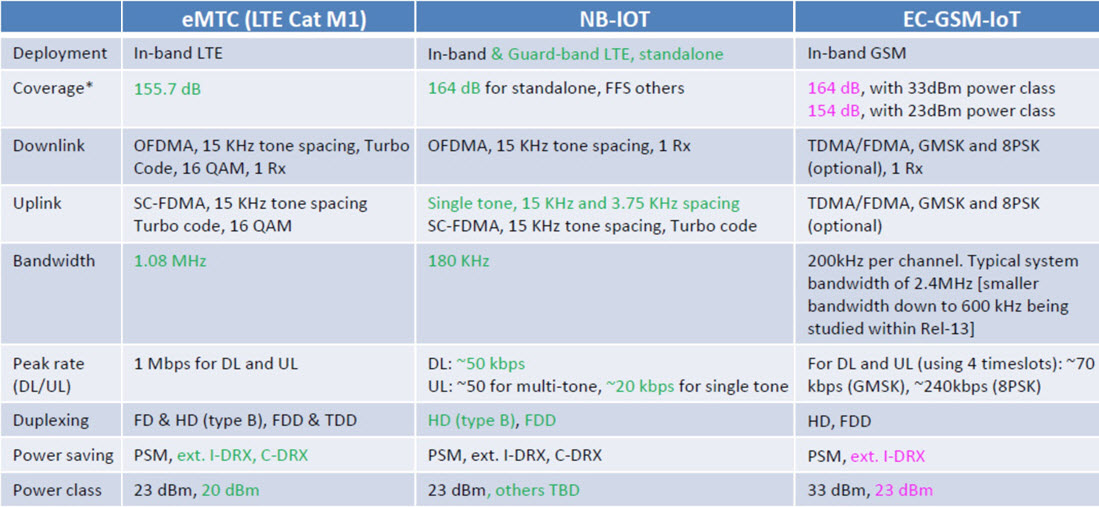Rise of the machines, and the options for connecting them
The Massive Internet of Things (IoT)
So, what exactly is a “thing”? Well, it depends on how you choose to define it. To me, a “thing” is any machine powered by a battery or plugged into an electrical power source. Although this is indeed a broad definition, who’d have thought a few decades ago that thermostats, refrigerators, front door locks, garage openers, lights, and even pets would be connected to the Internet, and easily accessible from anywhere at anytime all from the comfort of your smartphone? I think it would be quite a disservice to the ingenuity of the technology industry if we limited ourselves as to what a thing is, given our innovative and creative past. Anything that’s electrically powered and is given a network connection, can easily join the growing and expanding IoT.
Wirelessly Connecting the Machines
Most fanfare within the telecom industry related to wirelessly connecting the IoT involves discussions around cellular-centric acronyms such as 5G, LTE-M, EC-GSM-IoT, and NB-IoT, but it should be highlighted that there are other ways to wirelessly access machines, such as WiFi, Bluetooth, ZigBee, Near Field Communications (NFC), Z-Wave, and others. The chosen wireless technology ultimately depends on addressing application requirements at the lowest cost, especially when the sheer number of things to be connected (to the Internet) and interconnected (among themselves) is taken into account. For example, connecting 100 million things via a technology costing $1 more annually than a lower cost alternative needlessly wastes $100M each year. This is why there will be multiple networking technologies used going forward, and will be use-case dependent.
Modern cellular networks are designed to frequently transmit lots of video-centric data, and for long periods of time. This means existing cellular networks must be enhanced to cost-effectively support IoT requirements, and also support new power saving capabilities for inexpensive machines requiring a decade-long battery life!
From an application perspective, things like geographic coverage, data rates, end-to-end latency, security, battery life, and other metrics, will dictate whether WiFi makes more sense than Bluetooth, for example. The path from a sensor to the data center, where gathered sensor data is processed, will likely cross multiple different protocols. For example, the fitness monitor on your wrist gathers data (heartbeat, steps), sends it to your smartphone via Bluetooth, and onwards to a data center for processing via WiFi, then wireline. In this particular application, the cellular network can be used instead of WiFi but is often not, due to higher costs.
What our industry needs to ensure the commercial success of IoT and its use cases is a highly cost-effective way to interconnect machines requiring small amounts of data to be transmitted over great distances for long periods of time, at long intervals, and often from hard to reach places. This is contrary to cellular networks, which are simply not designed or optimized for use-cases transmitting very small amounts of infrequent data.
Modern cellular networks are designed to frequently transmit lots of video-centric data, and for long periods of time. This means existing cellular networks must be enhanced to cost-effectively support IoT requirements, and also support new power saving capabilities for inexpensive machines requiring a decade-long battery life!
The Future is Now, with Low Power Wide Area (LPWA) Networks
Although 5G is touted as the panacea to interconnecting things and enabling new and smarter use-cases related to cities, agriculture, and transportation, there are already viable ways to enable IoT over cellular Low Power Wide Area (LPWA) networks specifically designed for unique IoT network performance requirements. LPWA protocols offer low power, low cost, wide area coverage, and sufficient data rates to connect various types of sensors gathering data at regular, albeit long, intervals and send it to a storage and compute location, such as a MEC node, regional data center, or centralized data central office situated very far away.
3GPP offers three IoT-centric network standards, each of which uses licensed bands making them more secure and reliable than unlicensed networks, such as WiFi. The three technology standards, collectively called LPWA, are eMTC (also known as LTE-M, Category M1), NB-IoT, and EC-GSM-IOT, as summarized in Table 1.

Table 1: Summary for eMTC, NB-IoT, EC-GSM-IoT (Reference: 3GPP)
According to the GSMA, who represents the interests of mobile operators worldwide, the standardized LPWA technologies possess several characteristics making them particularly attractive to cellular IoT use-cases.
- Low power consumption (nanoamp range) enabling devices to operate for a decade on a single charge
- Low device unit cost
- Improved indoor/outdoor penetration coverage compared with existing wide area technologies
- Secure connectivity and strong authentication
- Optimized data transfer supporting small and intermittent blocks of machine data
- Simplified network topology and deployment
- Integrated into a unified/horizontal IoT/M2M platform, where operators have this in place
- Network scalability for capacity upgrade
A partial list of low power applications associated with the abovementioned characteristics is listed below, and once LPWA network technologies are more broadly deployed, the possible use-cases are truly limitless.
- Agriculture – livestock tracking, environmental monitoring and control
- Consumer – fitness wearables, pet tracking, appliance monitoring and control
- Industrial – machinery monitoring and control, vending machines
- Logistics – vehicle asset tracking
- Smart Buildings – smoke detectors, alarm systems, home/office automation
- Smart City – parking sensors, waste management, smart lighting
- Smart Rail – rail car traffic management and control
- Utilities – gas and water meters, smart grid,ongoing monitoring of systems generating energy
As shown in Table 1, the maximum data rates for LPWA options vary from 50kbps up to 1Mbps, which limits the supported IoT use cases. Although LTE-M provides similar latency as LTE, NB-IoT and EC-GSM-IoT provide higher to much higher latency, which further limits the supported IoT use cases. The logical question is, what is available for IoT applications requiring much higher data rates and/or much lower latency than LTE-M for such applications as tactile Internet, augmented/virtual (AR/VR) reality, and self-driving vehicles? 5G!
The logical question is, what is available for IoT applications requiring much higher data rates and/or much lower latency?
5G on the Near Horizon
NB-IoT and LTE-M networks are, and will continue to be, deployed for IoT use-cases where the supported mobility, speeds, and latency yields a viable business case. EC-GSM-IoT, which uses 2G networks most regions around the world are starting to sunset or even skip, will likely yield far more limited commercial success.
For new and emrging IoT use-cases requiring full mobility, extreme data rates into the gigabits per second, and/or an ultra-low latency of just a handful of milliseconds, 5G becomes the obvious choice and will unleash a whole new range of IoT use-cases and associated (and much needed) revenue streams. When compared to 4G/LTE, 5G promises 100x higher data rates, 100x more connected things, and 10x lower latency that ingenious IoT developers will undoubtedly find new and innovative ways to use. It should be noted that when 5G promises supporting 100x more connected devices, this refers mostly to machines. If were interconnecting tens of billions more humans, we’d have far bigger issues than latency and throughput to worry about!
Rise of the Connected Machines
There are multiple different ways available today to wirelessly connect machines from extending the life of 2G with EC-GSM-IoT, to enhancing 4G with LTE-M, to leveraging shiny new 5G networks. These options allow MNOs to best serve target markets at the right price point to ensure commercial success. The ultimate end goal is to connect tends of billions of machines and create the massive Internet of Things.
Are you ready for the rise of the machines?








